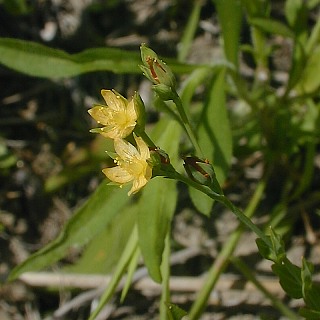Difference between revisions of "Hypericum gymnanthum"
(→Phenology) |
(→Conservation and Management) |
||
| Line 42: | Line 42: | ||
==Conservation and Management== | ==Conservation and Management== | ||
| − | ''H. gymnanthum'' is | + | ''H. gymnanthum'' is listed as endangered by the Maryland Department of Natural Resources, Natural Heritage Program and by the Ohio Department of Natural Resources, Division of Natural Areas and Preserves. It is also listed as extirpated by the Pennsylvania Department of Conservation and Natural Resources.<ref name= "USDA"> [https://plants.usda.gov/core/profile?symbol=CEAM USDA Plant Database]</ref> |
==Cultivation and restoration== | ==Cultivation and restoration== | ||
Revision as of 18:44, 23 May 2019
Common Names: claspingleaf St. Johnswort [1]
| Hypericum gymnanthum | |
|---|---|

| |
| Photo from Illinois Wildflowers Plant Database | |
| Scientific classification | |
| Kingdom: | Plantae |
| Division: | Magnoliophyta - Flowering plants |
| Class: | Magnoliopsida - Dicots |
| Order: | Theales |
| Family: | Clusiaceae |
| Genus: | Hypericum |
| Species: | H. gymnanthum |
| Binomial name | |
| Hypericum gymnanthum L | |

| |
| Natural range of Hypericum gymnanthum from USDA NRCS Plants Database. | |
Contents
Taxonomic Notes
Description
H. gymnanthum is a perennial forb/herb of the Clusiaceae family that is native to North America. [1]
Distribution
H. gymnanthum is found throughout the eastern United States is a number of states; Florida, Georgia, South Carolina, North Carolina, Alabama, Mississippi, Louisiana, Texas, Arkansas, Tennessee, Virginia, Missouri, Kansas, Illinois, Indiana, Ohio, West Virginia, Pennsylvania, Maryland, New Jersey, and New York. [1] It was added to the Kentucky flora in 2013, and is also disjunct in Guatemala, which might be an introduced population.[2]
Ecology
Habitat
Common habitats include pine savannas, wet pine flatwoods, sinkhole ponds in Virginia, and other wet habitats that are in the Atlantic and Gulf Coastal Plain, Eastern Mountains, great Plains, Midwest, North central and Northeast. [2] [1] Specimens have been collected from habitats including edge of small pond in longleaf pine woodland, wet roadside depression, moist loamy sands, edge of wet savanna, and pine canopy forests. [3]
Phenology
generally, H. gymnanthum flowers from June until September.[2] It has been observed flowering in May, July, and August. [4]
Conservation and Management
H. gymnanthum is listed as endangered by the Maryland Department of Natural Resources, Natural Heritage Program and by the Ohio Department of Natural Resources, Division of Natural Areas and Preserves. It is also listed as extirpated by the Pennsylvania Department of Conservation and Natural Resources.[1]
Cultivation and restoration
Photo Gallery
References and notes
- ↑ 1.0 1.1 1.2 1.3 1.4 USDA Plant Database
- ↑ 2.0 2.1 2.2 Weakley, A. S. (2015). Flora of the Southern and Mid-Atlantic States. Chapel Hill, NC, University of North Carolina Herbarium.
- ↑ URL: http://herbarium.bio.fsu.edu. Last accessed: June 2018. Collectors: L.C. Anderson, R.K. Godfrey, B.Boothe, M. Boothe, V. Craig, William Platt. States and counties: Florida (Jackson, Franklin, Wakulla, Gadsden, Liberty, Jefferson) Georgia (Thomas)
- ↑ Nelson, G. PanFlora: Plant data for the eastern United States with emphasis on the Southeastern Coastal Plains, Florida, and the Florida Panhandle. www.gilnelson.com/PanFlora/ Accessed: 22 MAY 2018